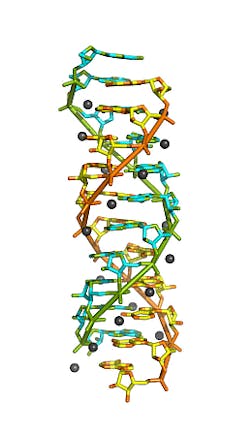Synchrotron light identifies RNA double helix structure
Scientists at McGill University (Montreal, QC, Canada) have crystallized a short RNA sequence, poly (rA)11, and used data collected at the Canadian Light Source (CLS; Saskatoon, SK, Canada) and the Cornell High Energy Synchrotron (Ithaca, NY) to confirm the hypothesis of a poly (rA) double helix. Their discovery, building on 50 years' worth of work by various scientists, will have interesting applications for research in biological nanomaterials as well as in fabricating bionanomachines (devices derived from living organisms that can perform medical diagnostics).
Related: AFM collaboration produces first in-situ view of DNA's double helix
âBionanomachines are advantageous because of their extremely small size, low production cost, and the ease of modification,â explains Kalle Gehring, a biochemistry professor at McGill University who led the work. âMany bionanomachines already affect our everyday lives as enzymes, sensors, biomaterials, and medical therapeutics.â
Gehring adds that proof of the RNA double helix may have diverse downstream benefits for the medical treatments and cures for diseases like AIDS, or even to help regenerate biological tissues. His team initially was looking for information about how cells turn mRNA into protein when they made their discovery.
For the experiments, Gehring and a team of researchers used data obtained at the CLS Canadian Macromolecular Crystallography Facility (CMCF) to successfully solve the structure of poly (rA)11 RNA. CMCF Beamline Scientist Michel Fodje said the experiments were successful in identifying the structure of the RNA and may have consequences for how genetic information is stored in cells.
âAlthough DNA and RNA both carry genetic information, there are quite a few differences between them,â says Fodje. âmRNA molecules have poly (rA) tails, which are chemically identical to the molecules in the crystal. The poly (rA) structure may be physiologically important, especially under conditions where there is a high local concentration of mRNA. This can happen where cells are stressed and mRNA becomes concentrated in granules within cells.â
With this information, researchers will continue to map the diverse structures of RNA and their roles in the design of novel bionanomachines and in cells during times of stress.
Research on the poly (rA) structure was funded by grants from the Natural Sciences and Engineering Research Council of Canada with support from the Canada Foundation for Innovation, the Government of Quebec, Concordia University, and McGill University.
The research team's paper appears in the journal Angewandte Chemie International Edition; for more information, please visit http://onlinelibrary.wiley.com/doi/10.1002/anie.201303461/abstract.
-----
Follow us on Twitter, 'like' us on Facebook, and join our group on LinkedIn
Subscribe now to BioOptics World magazine; it's free!

